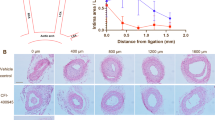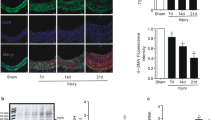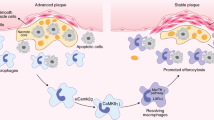Abstract
The transcription factor, E2F, plays a critical role in the trans-activation of several genes involved in cell cycle regulation. Previous studies showed that the transfection of cis element double-stranded decoy oligodeoxynucleotides (ODNs) corresponding to E2F binding sites inhibited the proliferation of vascular smooth muscle cells (VSMCs) and neointimal hyperplasia in injured vessels. We have developed a novel E2F decoy ODN with a circular dumbbell structure (CD-E2F) and compared its effects with those of the conventional phosphorothioated E2F decoy (PS-E2F) ODN. CD-E2F ODN was more stable than PS-E2F ODN, largely preserving its structural integrity after incubation in the presence of nucleases and sera. Moreover, CD-E2F ODN inhibited high glucose- and serum-induced transcriptional expression of cell cycle regulatory genes more strongly than PS-E2F ODN. Transfection of CD-E2F ODN resulted in more effective inhibition of VSMC proliferation in vitro and neointimal formation in vivo, compared with PS-E2F ODN. An approximately 40–50% lower dose of CD-E2F ODN than PS-E2F ODN was sufficient to attain similar effects. In conclusion, our results indicate that CD-E2F ODN may be a valuable tool in gene therapy protocols for inhibiting VSMC proliferation and studying transcriptional regulation.
This is a preview of subscription content, access via your institution
Access options
Subscribe to this journal
Receive 12 print issues and online access
$259.00 per year
only $21.58 per issue
Buy this article
- Purchase on Springer Link
- Instant access to full article PDF
Prices may be subject to local taxes which are calculated during checkout








Similar content being viewed by others
References
Scholer HR, Gruss P . Specific interaction between enhancer-containing molecules and cellular components Cell 1984 36: 403–411
Cereghini S, Blumenfeld M, Yaniv M . A liver-specific factor essential for albumin transcription differs between differentiated and dedifferentiated rat hepatoma cells Genes Dev 1988 2: 957–974
Berkowitz LA, Riabowol KT, Gilman MZ . Multiple sequence elements of a single functional class are required for cyclic AMP responsiveness of the mouse c-fos promoter Mol Cell Biol 1989 9: 4272–4281
Tanaka H et al. Sequence-specific interaction of alpha-beta-anomeric double-stranded DNA with the p50 subunit of NF kappa B: application to the decoy approach Nucleic Acids Res 1994 22: 3069–3074
Bielinska A, Shivdasani RA, Zhang LQ, Nabel GJ . Regulation of gene expression with double-stranded phosphorothioate oligonucleotides Science 1990 250: 997–1000
Clusel C et al. Ex vivo regulation of specific gene expression by nanomolar concentration of double-stranded dumbbell oligonucleotides Nucleic Acids Res 1993 21: 3405–3411
Lim CS et al. Sequence-independent inhibition of RNA transcription by DNA dumbbells and other decoys Nucleic Acids Res 1997 25: 575–581
Hosoya T et al. Sequence-specific inhibition of a transcription factor by circular dumbbell DNA oligonucleotides FEBS Lett 1999 461: 136–140
Khaled Z et al. Multiple mechanisms may contribute to the cellular antiadhesive effects of phosphorothioate oligonucleotides Nucleic Acids Res 1996 24: 737–775
Gao WY et al. Phosphorothioate oligodeoxynucleotides are inhibitors of human DNA polymerases and RNase H: implications for antisense technology Mol Pharmacol 1992 41: 223–229
Brown DA et al. Effect of phosphorothioate modification of oligodeoxynucleotides on specific protein binding J Biol Chem 1994 269: 26 801–26 805
Burgess TL et al. The antiproliferative activity of c-myb and c-myc antisense oligonucleotides in smooth muscle cells is caused by a nonantisense mechanism Proc Natl Acad Sci USA 1995 92: 4051–4055
Currier JW, Faxon DP . Restenosis after percutaneous transluminal coronary angioplasty: have we been aiming at the wrong target? J Am Coll Cardiol 1995 25: 516–520
Clowes AW, Reidy MA, Clowes MM . Mechanisms of stenosis after injury Lab Invest 1983 49: 208–215
Liu MW, Roubin Gs, King SB III . Restenosis after coronary angioplasty Circulation 1989 79: 1374–1387
Pagano M et al. Cyclin A is required at two points in the human cell cycle EMBO J 1992 11: 961–971
Pardee AB . A restriction point for control of normal animal cell proliferation Proc Natl Acad Sci USA 1974 71: 1286–1290
Weintraub SJ, Prater CA, Dean DC . Retinoblastoma protein switches the E2F site from positive to negative element Nature 1992 358: 259–261
Pagano MG, Draetta G, Durr J . Association of cdk2 kinase with the transcription factor E2F during S phase Science 1992 255: 1144–1147
Rosenblatt J, Gu Y, Morgan DO . Human cyclin-dependent kinase 2 is activated during S and G2 phases of the cell cycle and associates with cyclin A Proc Natl Acad Sci USA 1992 89: 2824–2828
Simons M et al. Antisense c-myb oligonucleotides inhibit intimal arterial smooth muscle cell accumulation in vivo Nature 1992 359: 67–73
Morishita R et al. Intimal hyperplasia after vascular injury is inhibiter by antisense cdk 2 kinase oligonucleotides J Clin Invest 1994 93: 1458–1464
Morishita R et al. Single intraluminal delivery of antisense cdc2 kinase and proliferating-cell nuclear antigen oligonucleotides results in chronic inhibition of neointimal hyperplasia Proc Natl Acad Sci USA 1993 90: 8474–8478
Morishita R et al. A gene therapy strategy using a transcription factor decoy of the E2F binding site inhibits smooth muscle proliferation in vivo Proc Natl Acad Sci USA 1995 92: 5855–5859
Morishita R et al. In vivo transfection of cis element “decoy” against NFkB binding site prevented myocardial infarction as gene therapy Nat Med 1997 3: 894–899
Weinberg RA . The retinoblastoma protein and cell cycle control Cell 1995 81: 323–330
DeGregori J, Kowalik T, Nevins JR . Cellular targets for activation by the E2F1 transcription factor includes DNA synthesis- and G1/S-regulatory genes Mol Cell Biol 1995 15: 4215–4224
Chu BC, Orgel LE . The stability of different forms of double-stranded decoy DNA in serum and nuclear extracts Nucleic Acids Res 1992 20: 5857–5858
Abe T et al. Specific inhibition of influenza virus RNA polymerase and nucleoprotein gene expression by circular dumbbell RNA/DNA chimeric oligonucleotides containing antisense phosphodiester oligonucleotides FEBS Lett 1998 425: 91–96
Marcus-Sekure CJ . Techniques for using antisense oligodeoxynucleotides to study gene expression Anal Biochem 1988 172: 289–295
Stein CA, Cohen JS . Oligodeoxynucleotides as inhibitors of gene expression: a review Cancer Res 1988 48: 2659–2668
Ahn JD et al. Transcription factor decoy for activator protein-1 (AP-1) inhibits high glucose- and angiotensin II-induced type 1 plasminogen activator inhibitor (PAI-1) gene expression in cultured human vascular smooth muscle cells Diabetologia 2001 44: 713–720
Natarajan R et al. Angiotensin II signaling in vascular smooth muscle cells under high glucose conditions Hypertension 1999 33: 378–384
Yasunari K et al. Mechanisms of action of troglitazone in the prevention of high glucose-induced migration and proliferation of cultured coronary smooth muscle cells Circ Res 1997 81: 953–962
Acknowledgements
This study was supported by a grant from the Korea Health 21 R&D project, Ministry of Health & Welfare, Republic of Korea (HMP-99-M-08-0004 and 02-PJ-1-PG10-20708-0007)
Author information
Authors and Affiliations
Rights and permissions
About this article
Cite this article
Ahn, J., Morishita, R., Kaneda, Y. et al. Novel E2F decoy oligodeoxynucleotides inhibit in vitro vascular smooth muscle cell proliferation and in vivo neointimal hyperplasia. Gene Ther 9, 1682–1692 (2002). https://doi.org/10.1038/sj.gt.3301849
Received:
Accepted:
Published:
Issue Date:
DOI: https://doi.org/10.1038/sj.gt.3301849
Keywords
This article is cited by
-
A critical role of E2F transcription factor 2 in proinflammatory cytokines-dependent proliferation and invasiveness of fibroblast-like synoviocytes in rheumatoid Arthritis
Scientific Reports (2018)
-
Systemic Administration of Ribbon-type Decoy Oligodeoxynucleotide Against Nuclear Factor κB and Ets Prevents Abdominal Aortic Aneurysm in Rat Model
Molecular Therapy (2011)
-
Neointimal hyperplasia associated with synthetic hemodialysis grafts
Kidney International (2008)
-
Transcription factor decoy oligonucleotide-based therapeutic strategy for renal disease
Clinical and Experimental Nephrology (2007)
-
Inhibitory effect of ribbon-type NF-κB decoy oligodeoxynucleotides on osteoclast induction and activity in vitro and in vivo
Arthritis Research & Therapy (2006)



